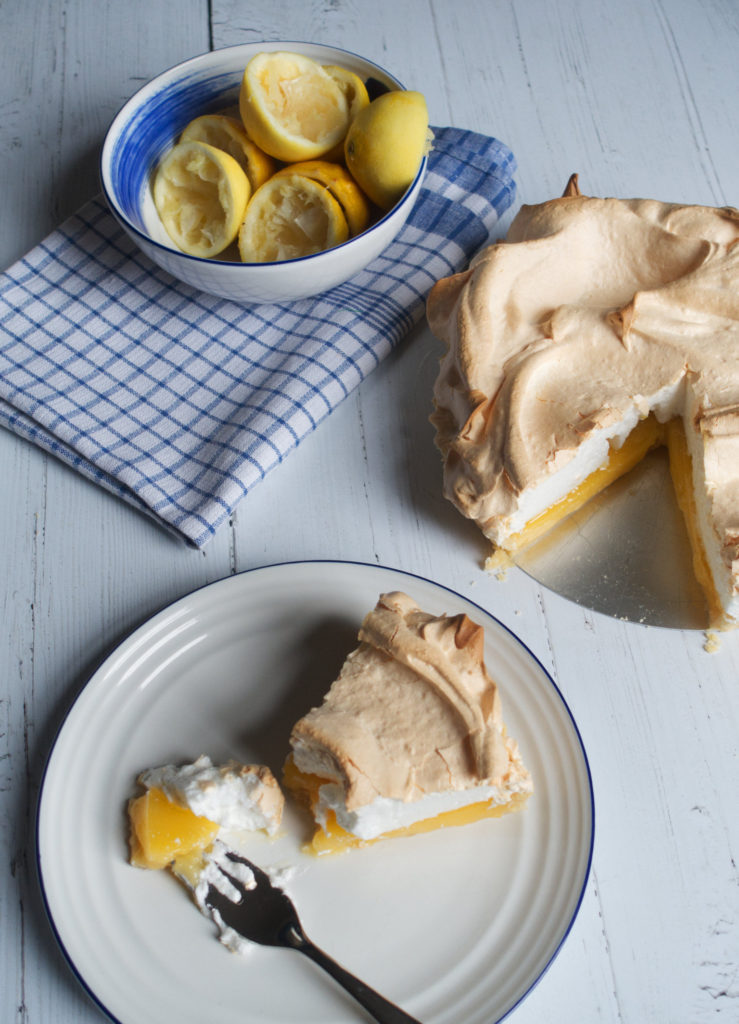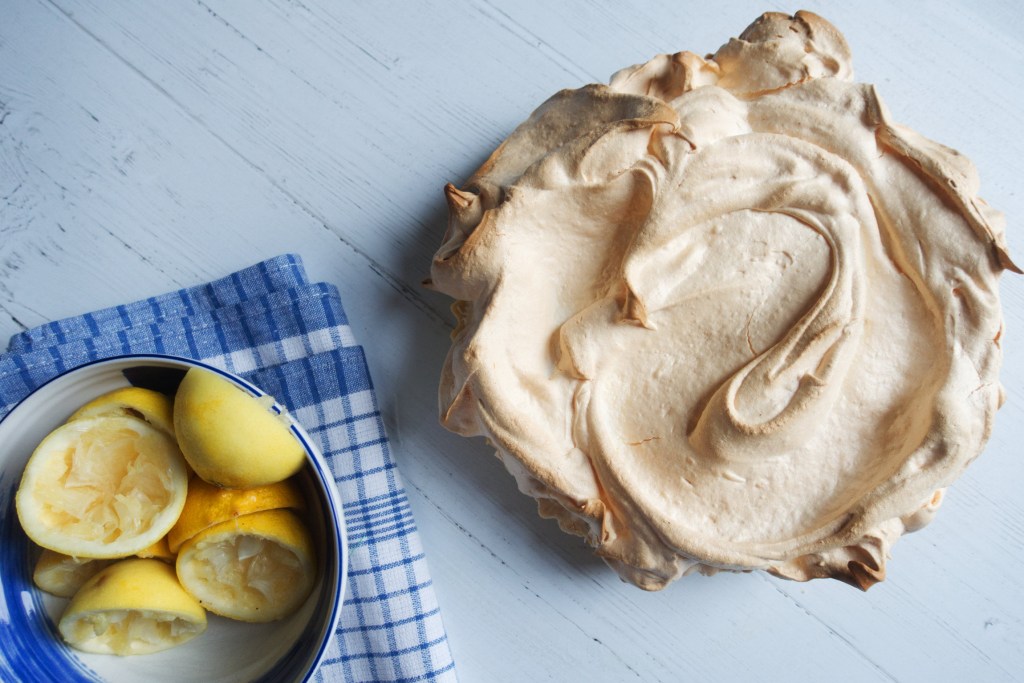I often find myself turning to lemon-filled recipes in January. I think it’s something my baking subconscious realizes before I do — that cold, dark days require the antithesis, something bright and bold, something cheering. You know what they say: when life gives you lemons, make lemon meringue pie.
Unlike its austere, pared back French cousin, the tarte au citron, the lemon meringue pie is never going to be a subtle pudding: a lurid, Chartreuse center hidden by big billows of toasted meringue, piled ludicrously, disproportionately, toweringly tall. It quivers and wobbles on the plate, crisp and firm on the outer edge, giving way to a marshmallowy interior. But that’s the point isn’t it? It isn’t sophisticated or chic or cool. It’s fun, and God, couldn’t we all do with a bit of fun right now?
The filling isn’t quite a curd, although it looks like one. Instead, a slurry is made with the lemon juice, water, sugar and cornflour, and brought to the boil to cook out the cornflour and thicken the mixture. This is then used to temper the egg yolks, like you would if you were making a custard with milk. Its result is a really brightly flavored lemon gel that sits neatly in the pastry case, and tastes thrillingly, zippily, mouth-puckeringly sweet-sour. There’s a certain logic to the dish, which I rather like. The lemon filling requires four egg yolks to enrich it into something luscious and smooth, while the meringue is made of four egg whites whisked to stiff peaks until glossy and thick — it’s a symbiotic pudding, nothing wasted. Italian or Swiss meringue, in which the egg whites are cooked during the meringue making process, have no place here. The meringue on an LMP (the lemon meringue pie is so far from formal, I feel comfortable abbreviating it) should be crisp when cooked, and a pale golden brown; it needs a period in the oven, not a blast from a blow torch.
I like an American-style pie crust for this pie, rather than something fancier. American pie dough is quick to pull together, easy to handle, and provides a nice, unsweetened contrast to the lemon and the meringue fillings. Stop short of completely combining the flour and butter, mixing the water into it when the butter is still pea-sized: this will form little pockets of butter in the pie dough, which will make the finished product.
This recipe will work in either an eight- or nine-inch tart tin, and the pastry shell can be made up to three days in advance, and kept refrigerated, or baked and kept in an airtight container. Lemon meringue pie’s only failing is its shelf-life: the French meringue sitting on the lemon gel means that it sags and weeps a little bit at the end of the day (don’t we all, sometimes): so plan to enjoy the whole thing on the day of cooking. Living in a two-person household during lockdown means that I can attest that any spare slices are welcomed by socially-distant neighbors.

Lemon Meringue Pie
Makes: 1 8 or 9 inch pie
Takes: 1 hour, plus chilling
Bakes: 20 minutes
For the crust
8oz flour
2½fl oz very cold water
4ozbutter, cold, cut into dice
1 tablespoon caster sugar
½ teaspoon fine salt
For the filling
5 lemons, juiced
3 lemons, zested
6oz caster sugar
3⅓fl oz water
1oz cornflour
4 egg yolks
1¼ butter
For the meringue
9½oz granulated sugar
4 egg whites
2 teaspoons cornflour
1. First make the pie crust: rub the flour and butter together between your fingertips or using a pastry cutter, until the chunks of butter are pea-sized. Stir through the sugar and salt. Pour the cold water into the rubble mixture, and use a knife to cut the water into the mix. When the dough starts to come together, use your hands to briefly knead it together into a cohesive dough. Wrap tightly in clingfilm and refrigerate for at least half an hour
2. On a floured surface, roll out the dough into an 11-inch circle. Roll this circle up onto a floured rolling pin, and then unroll it carefully over an eight- or nine-inch tart tin. Ease the pastry so it sits flush against the base and edged of the tart tin: I use a little excess pastry balled up and dipped in flour to help me do this. Prick all over with a fork, place the whole thing on a baking tray, and refrigerate for at least half an hour
3. Preheat the oven to 350°F. Line the pastry case with oven-safe clingfilm or baking paper, and fill with baking beans or other pastry weights (I use dry rice), right up to the top of the case. Bake for 20 minutes, remove the baking beans and cling film or baking paper, and return to the oven for another 10 minutes. Set to one side to cool for 15 minutes
4. Heat the lemon juice, lemon zest and sugar together in a medium-sized sauce pan until the sugar dissolves. Make a slurry with the cornflour and water and add this to the lemon syrup: cook over a medium heat until the mixture boils and thickens, stirring the whole time
5. Put the egg yolks in a heatproof bowl, and briefly whisk until the egg yolks are paler than before. Pour some of the hot lemon mixture over the egg yolks, whisking to combine. Return the mixture to the pan and the heat, and stir for a couple of minutes until thick. Stir through the butter until combined
6. Spoon the lemon mixture into the tart case
7. To make the French meringue, whisk the egg whites to soft peaks. Add the sugar a tablespoon at a time, only adding the next tablespoon when the previous one is fully incorporated. Whisk until the meringue forms stiff peaks and is thick and glossy. Briefly whisk in the cornflour
8. Spoon the meringue onto the tart case, starting at the edges, making sure it touches the pastry (this will form a seal for the tart). Pile the centre of the tart high with meringue. Bake for 20 minutes until the meringue is crisp and starting to brown. Allow to cool for an hour before demolding from the tart case and slicing
This article was originally published on Spectator Life.


















